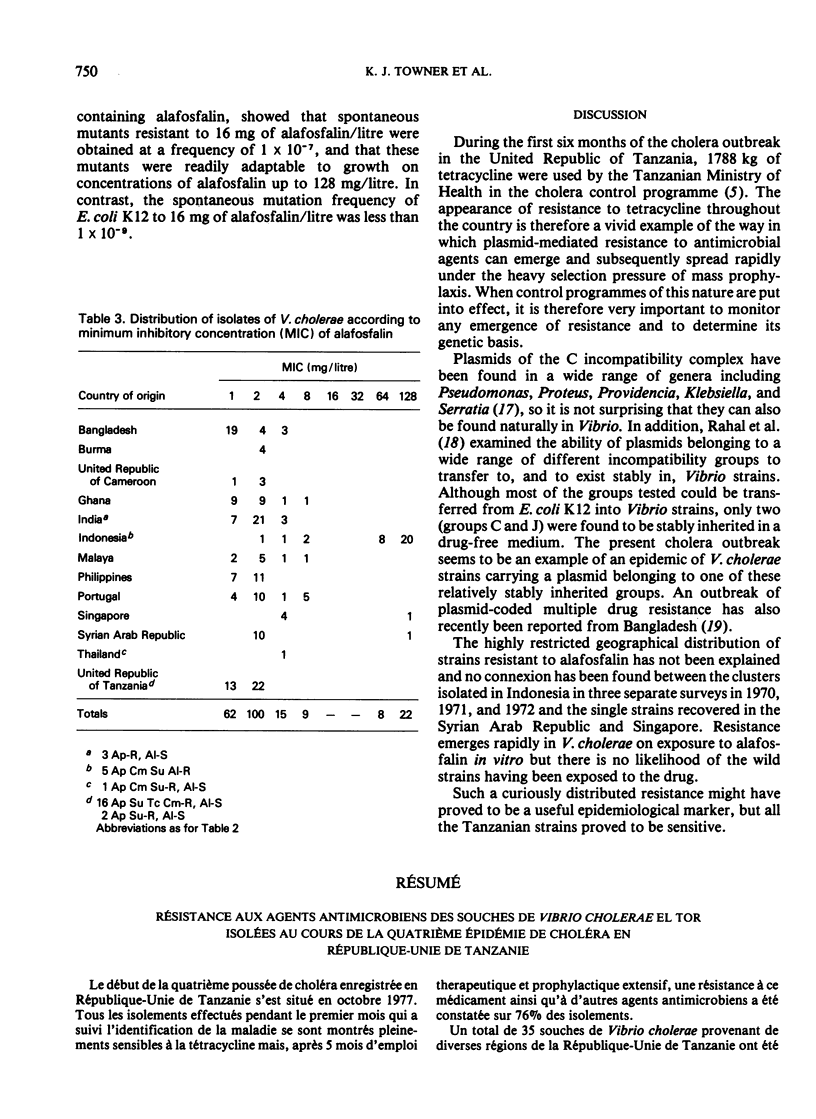Abstract
Isolates of Vibrio cholerae obtained immediately after the outbreak of the fourth recorded epidemic of cholera in the United Republic of Tanzania were sensitive to tetracycline, but after five months of its extensive therapeutic and prophylactic use, 76% of the isolates were observed to be resistant to this and other antimicrobial agents. The appearance of resistance was found to be due to the rapid spread of antibiotic resistance plasmids belonging to the C incompatibility complex. Although most plasmid incompatibility groups have been shown to be unstable in V. cholerae, the strains found in the present epidemic seem to carry a plasmid belonging to one of the few relatively stable groups. These findings emphasize the importance of monitoring any emergence of bacterial resistance that may occur when mass prophylaxis programmes are in operation and also the importance of determining the genetic basis of the resistance mechanism.
Full text
PDF




Selected References
These references are in PubMed. This may not be the complete list of references from this article.
- Allen J. G., Atherton F. R., Hall M. J., Hassall C. H., Holmes S. W., Lambert R. W., Nisbet L. J., Ringrose P. S. Phosphonopeptides as antibacterial agents: alaphosphin and related phosphonopeptides. Antimicrob Agents Chemother. 1979 May;15(5):684–695. doi: 10.1128/aac.15.5.684. [DOI] [PMC free article] [PubMed] [Google Scholar]
- Atherton F. R., Hall M. J., Hassall C. H., Lambert R. W., Ringrose P. S. Phosphonopeptides as antibacterial agents: rationale, chemistry, and structure-activity relationships. Antimicrob Agents Chemother. 1979 May;15(5):677–683. doi: 10.1128/aac.15.5.677. [DOI] [PMC free article] [PubMed] [Google Scholar]
- Bachmann B. J. Pedigrees of some mutant strains of Escherichia coli K-12. Bacteriol Rev. 1972 Dec;36(4):525–557. doi: 10.1128/br.36.4.525-557.1972. [DOI] [PMC free article] [PubMed] [Google Scholar]
- Barth P. T., Grinter N. J. Comparison of the deoxyribonucleic acid molecular weights and homologies of plasmids conferring linked resistance to streptomycin and sulfonamides. J Bacteriol. 1974 Nov;120(2):618–630. doi: 10.1128/jb.120.2.618-630.1974. [DOI] [PMC free article] [PubMed] [Google Scholar]
- Guerry P., LeBlanc D. J., Falkow S. General method for the isolation of plasmid deoxyribonucleic acid. J Bacteriol. 1973 Nov;116(2):1064–1066. doi: 10.1128/jb.116.2.1064-1066.1973. [DOI] [PMC free article] [PubMed] [Google Scholar]
- Hedges R. W., Jacob A. E. A 98 megadalton R factor of compatibility group C in a Vibrio cholerae El Tor isolate from southern U.S.S.R. J Gen Microbiol. 1975 Aug;89(2):383–386. doi: 10.1099/00221287-89-2-383. [DOI] [PubMed] [Google Scholar]
- Hedges R. W., Vialard J. L., Pearson N. J., O'Grady F. R plasmids from Asian strains of Vibrio cholerae. Antimicrob Agents Chemother. 1977 Apr;11(4):585–588. doi: 10.1128/aac.11.4.585. [DOI] [PMC free article] [PubMed] [Google Scholar]
- Jacob A. E., Hobbs S. J. Conjugal transfer of plasmid-borne multiple antibiotic resistance in Streptococcus faecalis var. zymogenes. J Bacteriol. 1974 Feb;117(2):360–372. doi: 10.1128/jb.117.2.360-372.1974. [DOI] [PMC free article] [PubMed] [Google Scholar]
- O'Grady F., Lewis M. J., Pearson N. J. Global surveillance of antibiotic sensitivity of Vibrio cholerae. Bull World Health Organ. 1976;54(2):181–185. [PMC free article] [PubMed] [Google Scholar]
- Towner K. J., Pearson N. J., Cattell W. R., O'Grady F. Trimethoprim R plasmids isolated during long-term treatment of urinary tract infection with co-trimoxazole. J Antimicrob Chemother. 1979 Jan;5(1):45–52. doi: 10.1093/jac/5.1.45. [DOI] [PubMed] [Google Scholar]


